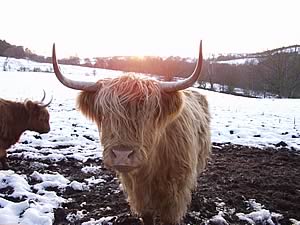|
Beef producers across Scotland are invited to join in farm walks
on the 4th and 13th December on two commercial farms where best
practice techniques for outwintering cattle on hill or woodland
areas are being evaluated.
The project which is run by SAC, is co-funded by QMS and
supported by Rumenco.
These farm walks, in Dumfriesshire and Argyll, follow on
from the highly successful outwintering work on brassicas
carried out by SAC and QMS and are the latest in a series
of walks and demonstrations which have been attended by
around 1400 farmers over the last three years.
Both of the farms, Auchenbainzie in Dumfriesshire, and
Glencreran Estate in Argyll, have been outwintering cattle
for a number of years and have adopted systems which best
suit their own conditions. The farm walks will therefore
focus on these systems and will enable farmers attending
to consider and assess how the system could be best adapted
to suit their own farm.
Speakers lined up to take part include, in each case;
the host farmer, SAC beef cattle specialists Gavin Hill
and Basil Lowman, QMS Technical Projects Manager Johnny
Mackey, local SAC Farm Business Consultants, local vets
and officials from the State Veterinary Services and Scottish
Government offices.
The presence of veterinary specialists will provide an
opportunity to discuss cattle welfare and ‘getting
the environmental conditions right’.
An important element of outwintering cattle on hills in
certain areas is the potential problems that could occur
from ticks. As part of the project, ticks on both the hills
and cows are being monitored. SAC and local vets will be
discussing this issue and the strategy that has been put
in place to control the problem.
Details of the Farm Walks:
Tuesday 4th December 2007 at 1.00pm
Auchenbainzie, Penpont, Thornhill, Dumfriesshire, DG3 4NE.
Courtesy of farmer, David Kirkpatrick
- There is a total of 857 ha split between hill and upland
grazing, ranging from 60 metres to 300 metres. The labour
force is 2.5 on the upland beef and sheep farm with 230
Spring calvers, and 1,700 breeding ewes. There are 180
dairy cows on another farm.
- Stabiliser bulls are now being
used with the aim of having cattle that can look after
themselves, be outwintered on the hill for as long as
possible, be easy calving and have good maternal characteristics.
The farm now has a good mix of the older Angus cross
cows with the younger Stabilser cows allowing comparisons
to be made. This is of extreme interest to many cattle
farmers.
- The farmer, David Kirkpatrick aims to find the
optimum number of cows that can be taken through the
winter on the hill then calved outside without using
kale.
There are no sheep or cattle on hill from June until
cows are put on in October.
- There are no first calvers,
old cow or thin cows on the hill. Grazing on green hill
area of about 200 hectares through October to December
is only supplemented with minerals. In the New Year cows
are brought down and put onto kale (45 acres) and then
taken inside one month prior to calving.
- The future aim
is to graze the cattle on the hill to calving with no
additional feed. No kale would be grown.
Thursday 13th December 2007 at 1.00pm
Glencreran Estate, Fasnacloich, Appin, Argyll, PA38 4BJ
Courtesy of farmer, John Livingstone
- The estate totals 5,300 hectares dominated by hill
land rising from sea level to 950 m. Silage is taken
from 40 hectares of improved land. Rainfall is 3,000 – 4,000
mm with mild winters but heavy snow on the mountain
peaks. The estate is currently in a number of schemes
including a Rural Stewardship Scheme.
- In 2003/2004,
1,000 ewes were removed mainly due to the shortage
and cost of casual labour for gathering. There are
currently no sheep. There are 50 cows and the objective
is to increase this number to 60 in the medium term
- mainly spring/summer calving. The early born calves
(March) are sold off their mothers in November/December
with the rest being overwintered and sold in the
spring. Two Limousin and one Highland bull are used
on predominantly Limousin crosses.
- The cows are not
wintered on the hills but in open woodland where
they are fed silage. Cake is then introduced. Prior
to calving the cows are moved onto enclosed areas.
(The woodland has no economical value apart from
shelter for the cows.) Although silage is fed the
benefit of this system is that the cattle are outwintered
in areas that can take them through the winter, and
not taken in to sheds which have a high financial
cost.
- A current objective is to find ways to cheapen
the cow systems.
Further information from Gavin
Hill, SAC.
 Lothian and Borders Farmers Invited to Participate in New Arable Monitor Farm Lothian and Borders Farmers Invited to Participate in New Arable Monitor Farm
 Better Returns from Buying and Selling Store Cattle Better Returns from Buying and Selling Store Cattle
 FAO Forecasts Continued High Cereal Prices FAO Forecasts Continued High Cereal Prices |


